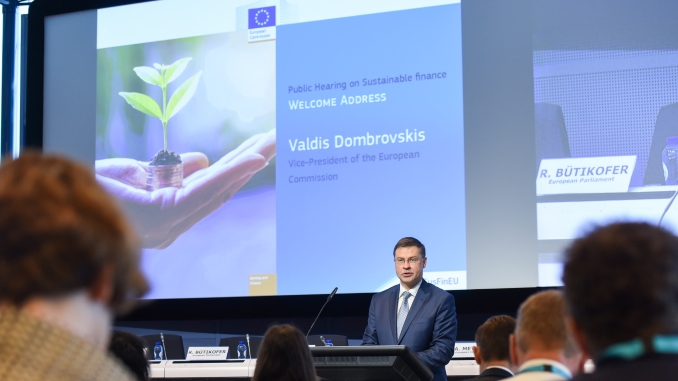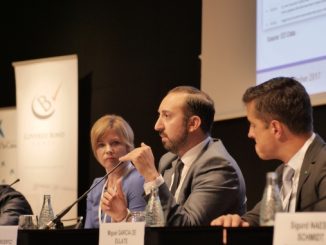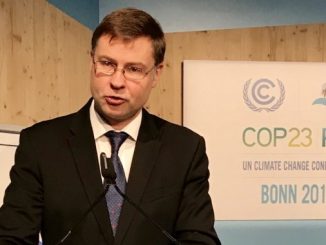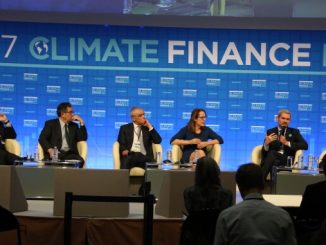
An EU standard and label for green bonds and other sustainable assets can unlock the market’s potential, according to recommendations presented to the European Commission, while at a hearing yesterday (Tuesday) the EMF-ECBC called for the establishment of green mortgages to let the industry “do our job”.
The recommendations come from an interim report published on Thursday of last week (13 July) and discussed at a public hearing in Brussels.
The report was produced by the high-level expert group (HLEG) on sustainable finance, a group of 20 senior experts convened by the European Commission last December. It represents part of the Commission’s broader efforts to map out an EU strategy on sustainable finance, a priority of its Capital Markets Union (CMU) Action Plan.
“Europe needs a financial system that promotes sustainable economic development rather than boom and bust; sustainable social development rather than inequality and exclusion; and sustainable environmental development rather than damaging the endowments of nature,” said Christian Thimann, chair of the HLEG, presenting the report on Tuesday.
The interim report proposed certain actions that could be adopted early, including the development of an EU standard and label for green bonds and other sustainable assets, which, Thimann said, are now within reach and can, with the Commission’s support, be fully developed.
“The EU green bond market has yet to reach its full potential and can serve as a basis for other sustainable asset classes. To spur market growth, the EU should consider introducing official European green bonds standards.”
Other early recommendations include assessing how fiduciary duty could incorporate sustainability and how to improve financial institutions’ disclosure on sustainability. The Commission said it would start exploring the early recommendations as of now.
The HLEG will meanwhile continue to discuss and analyse other policy areas, including banking, governance of financial institutions, and the integration of sustainability considerations into bond ratings and benchmark indices, and may offer additional recommendations in these areas in the final version of its report.
Opening the hearing, Valdis Dombrovskis, vice president, European Commission, said one of the three key targets of the Commission is to ensure investment, including private capital, flows towards green and sustainable projects. He noted that green finance is booming, with issuance of green bonds forecast to reach Eu131bn in 2017, up from Eu70bn last year.
“But there is still a lot of untapped potential in the market for green and sustainable assets,” he said. “To expand these markets further, we need to give institutional and retail investors clarity, and trust in the green or sustainable nature of investment projects – this will help prevent green-washing.
“We also need to improve access for retail investors, to broaden the base of sustainable finance. And finally, we need to give institutional investors the legal certainty they need to better direct their capital towards a long term impact.”
Dombrovskis acknowledged that in this area, the recommendations for a classification system for green and sustainable assets and a European standard and label for green bonds and other products have “great potential”. Regulatory reforms such as rules that require the disclosure of data on the environmental impact of residential mortgages and auto-loans packaged in securitisations can also contribute, he said.
“We are also working on changing the investment culture and behaviour of market participants,” said Dombrovskis. “For example, we have taken steps to incentivise pension funds and shareholders to take sustainability into account in their investment decisions.”
EMF-ECBC seeks conditions to mobilise
On a panel discussing how financial regulation can support sustainable finance, Luca Bertalot, secretary general of the European Mortgage Federation-European Covered Bond Council (EMF-ECBC), spoke of the challenges faced by the mortgage lending industry.
“If we look from a mortgage lending perspective, we have to convince 510 million European citizens to change their house,” he said. “We also need to convince 8000 bank CEOs that offering a green product to these 510 million people is a profitable job, and that it will not cost them too much.”
Bertalot said three things are required for this effort to be successful: a clear, consistent message from European institutions on the importance of energy efficiency and green initiatives; a regulatory “green sandbox” that offers support for banks developing green products – such as preferential treatment under leverage ratios, CRR or LCR; and the establishment of green assets through which to support green assets.
“We cannot have green bonds if we do not have green collateral.”
The EMF-ECBC and partners launched the Energy Efficient Mortgages initiative in September to explore ways to mobilise private mortgage financing to boost energy efficient building renovation across Europe, with the ultimate objective of establishing a framework for a standardised Energy Efficient Mortgage product that lenders can offer to borrowers seeking to purchase and retrofit energy efficient properties. The Commission is encouraging and supporting the Energy efficient Mortgages Action Plan (EeMAP).
Bertalot said the development of green mortgages offered a good starting point.
“It is easy, because the parameters for risk for mortgages are loss given default – so, how much a bank can lose on mortgages – and also the probability of default of the borrower,” he said. “It is something that is priceable, and is affected by energy efficiency.”
The EEM initiative is seeking to justify a lower risk weight for energy efficient property loans, based on both a lower probability of default (due to lower operating costs on green buildings) and a lower loss given default (based on values holding up better).
“So what we are asking for is not a discount factor about risk,” Bertalot said. “It is simply giving the possibility to banks to realign the risk and function of the energy efficiency impact.
“We are not asking for a free lunch. We are just asking, ‘please, give us the instrument and the conditions to do our job’.”
The HLEG will meet to discuss feedback to the consultation on 11-12 September, with comments required to be submitted by 6 September if they are to be considered at the meeting. The consultation will close on 20 September and the final report is expected in December.
Mark Lewis, a member of the Financial Stability Board’s Task Force on Climate-related Financial Disclosures (TCFD), gave the hearing an overview of recommendations recently published by the task force, which are applicable to organisations across sectors – including banks, asset managers and insurance companies – and jurisdictions.
Lewis expected the recommendations suggest how such organisations can improve their climate-related disclosures and are structured around four thematic areas: the organisation’s governance around climate risks and opportunities; the impacts of risks and opportunities on its strategy; the way it identifies, assesses and manages risks; and the metrics and targets used to assess and manage risks and opportunities.
Photo: Jennifer Jacquemart/EC – Audiovisual Service; Copyright: EU




1 Trackback / Pingback
Comments are closed.